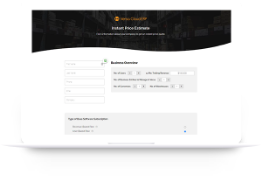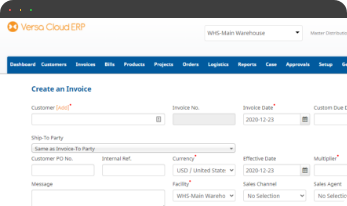Optimize your business with effective inventory control in an ERP system.
Inventory control involves tracking stock levels and monitoring customer demand to ensure that businesses have the right products in the right quantities at the right time. Accurate inventory management is crucial to avoid overstocking or understocking, which can lead to inefficiencies and lost sales. Properly managing stock quantities also helps prevent theft and damage. By maintaining the appropriate inventory levels, businesses can effectively manage their supply chains and enhance customer service operations, ultimately improving efficiency and profitability.
What is Inventory Control?
Inventory control, also known as stock control, ensures that an organization maintains the right amount of supply. By implementing effective internal and production controls, companies can meet customer demand and maintain financial flexibility.
Successful inventory control relies on data from various areas, including purchases, reorders, shipping, warehousing, storage, receiving, customer satisfaction, loss prevention, and turnover. This practice aims to maximize profit from minimal investment in stock without compromising customer satisfaction. Effective inventory control allows businesses to evaluate their current asset status, account balances, and financial reports. It also helps prevent issues like stockouts; for instance, Walmart estimated a $3 billion loss in sales in 2014 due to inadequate inventory control leading to stockouts.
A key component of inventory control is supply chain management (SCM), which oversees the flow of raw materials, goods, and services until they reach the company or customers. Warehouse management is also a crucial aspect of stock control, involving the integration of product coding, reorder points, reports, product details, inventory lists, counts, and methods for selling or storing. This synchronization of sales and purchases with available stock is essential for efficient warehouse management.
Inventory management is a broader concept encompassing the entire process of procuring, storing, and profiting from merchandise or services. While inventory control focuses on regulating existing stock within the warehouse, inventory management covers everything from procurement to the final destination of the product.
Inventory control practices and policies should extend beyond finished and raw goods. The following graphic illustrates the various aspects of a business that can be managed using these practices.
The Scope of an ERP in Inventory Control: Extending Beyond Finished and Raw Goods

Why Is Inventory Control Important?
Inventory is one of the largest capital costs for any product-based business. On the balance sheet of such companies, inventory often constitutes a significant portion of current assets and consumes a considerable amount of working capital.
Effective inventory control helps mitigate the costs associated with over-purchasing inventory and the challenges of running out of necessary stock. While some companies adopt just-in-time ordering to minimize inventory, nearly all businesses need some inventory, best managed through inventory control systems.
Reducing inventory can free up funds for expansion or increase profits. Conversely, maintaining optimal inventory levels through stringent control processes can lead to higher sales and profits. Optimizing inventory in warehouses, stock rooms, supply rooms, or storefronts is a surefire way to cut costs and manage products more effectively.
How can an ERP help Improve Your Business Practice Inventory Control?
Proper inventory control procedures ensure a business operates at optimal financial levels and meets customer needs and expectations. According to the 2015 “Global State of Multichannel Customer Service Report,” 62% of customers have stopped doing business with a brand due to poor customer service, with frustration over out-of-stock or backordered items being a significant factor.
Research indicates that out-of-stock items can cause a convenience store to lose one in every 100 customers entirely. Additionally, 55% of shoppers will not purchase an alternative item when their preferred product is out of stock. Effective inventory control can address several issues that lead to lost sales or increased expenses, including:
- Spoilage
- Deadstock
- Excess storage costs
- Cost inefficiency
- Decreased sales
- Loss of loyal customers
- Excess stock
- Inventory mismanagement
- Misplaced goods in the warehouse
Implementing robust inventory control practices can significantly enhance business performance by reducing costs, improving customer satisfaction, and increasing profitability.
4 Ways to Control Inventory
Inventory control is the process of determining what you have and where it’s stored, allowing for accurate evaluation and management. Different businesses, especially at various stages of growth, require different inventory control methods. Some methods can be too complex for smaller companies.
An effective inventory control system should track inventory levels, create orders, and manage stock distribution. Here are four basic systems for tracking inventory:
Inventory Control Method: Manual Tracking
- Description: Manually logging inventory with pen and paper, using a ledger or stock book.
- Best For: Small businesses with few items.
- Challenges: This method is labor-intensive and doesn’t allow for easy data analysis or planning.
Inventory Control Method: Stock Cards
- Description: Uses stock cards (or bin cards) to record the running unit price, sale price, and inventory count for each product.
- Best For: Large warehouses or stock rooms.
- Key Features: Tracks purchases, sales, returns, and other stock withdrawals. Allows for additional notes about stock issues.
- Challenges: Requires consistent updates and accurate recording of unusual stock pulls to maintain data accuracy.
Inventory Control Method: Simple Spreadsheets
- Description: Uses spreadsheets like Microsoft Excel to track inventory.
- Best For: Small businesses looking to start automating inventory tracking.
- Key Features: Allows for electronic data capture, customization to meet specific needs and basic coding for automation.
- Challenges: Requires detailed knowledge of the spreadsheet’s setup. Considered manual unless enhanced with advanced macros or coding.
Inventory Control Method: Basic Inventory Software
- Description: Low-cost software designed for small and medium-sized businesses.
- Best For Businesses looking for simple automation and real-time stock updates.
- Key Features: Often cloud-based, integrates with point-of-sale systems, offers analytics and reporting, and can scale with business growth.
- Advantages: Provides real-time updates, cost comparisons, reorder creation, and sales analysis.
Some businesses prefer simpler inventory tracking systems, while others plan for growth and scalability. For those aiming to expand, advanced software solutions offer robust features:
Inventory Control Method: Advanced Inventory Software Versa Cloud ERP
- Description: Designed for comprehensive inventory tracking, Versa Cloud ERP has built-in integration which, provides scalable options, and offers detailed analytics and templates.
- Best For: Small and midsize businesses looking for advanced capabilities.
- Advantages: Now more affordable and accessible, making them a viable option for businesses of various sizes.
By choosing the right inventory control method, businesses can optimize their operations, reduce costs, and better meet customer demands.
8 Tactics for Inventory Control
These are indeed comprehensive inventory control techniques that cover various aspects of managing stock efficiently. Each method has its advantages and challenges, and choosing the right one depends on factors like the nature of your business, the type of products you deal with, and your suppliers’ reliability. Let’s break down each technique:
1. FIFO and LIFO: These are accounting methods for valuing inventory. While FIFO assumes the oldest inventory is sold first, LIFO assumes the newest inventory is sold first. These methods impact financial statements and tax implications.
2. Min-Max Inventory Control: Setting minimum and maximum stock levels helps in maintaining optimal inventory levels, but it can lead to stockouts or excess inventory if not managed properly.
3. JIT Inventory: JIT aims to reduce waste and inventory costs by ordering materials or goods just in time for production or sale. However, it requires strong supplier relationships and efficient logistics to avoid stockouts.
4. Two- or Three-Bin System: This simple system helps in identifying reorder points but may not be suitable for businesses with fluctuating demand or large orders.
5. Fixed Order Quantity: Ordering a specific quantity each time helps in minimizing reorder mistakes and storage issues. It’s suitable for businesses with stable demand and predictable lead times.
6. Fixed Period Ordering: Replenishing inventory at regular intervals helps in managing cash flow but may lead to stockouts during unexpected demand spikes.
7. Vendor-Managed Inventory (VMI): Letting suppliers manage inventory can reduce administrative burden but requires trust and collaboration with suppliers.
8. Set Par Levels: Maintaining minimum inventory levels ensures flexibility and efficiency but requires periodic adjustments and consideration of safety stock for emergencies.
Combining these techniques or tailoring them to suit specific needs can help businesses achieve optimal inventory management and meet customer demands effectively.
Key Best Practices for Inventory Control
Effective inventory control methodologies vary among companies, but clarity, well-defined policies, and tailored software are essential. Labeling items, employing quality standards, and managing relationships with suppliers are critical components.
- Choose a Management Improvement Methodology: Implementing management methodologies like Kaizen, Lean, or Six Sigma can enhance overall business operations.
- Optimize Purchasing Procedures: Utilize data and forecasting to control purchasing, identify items based on customer demand, and adjust safety stock and reorder points.
- Manage Supplier Relationships: Nurture strong relationships with suppliers to anticipate and solve problems, negotiate terms, and ensure timely restocking.
- Create Automated Reports: Utilize inventory management systems to analyze and report data on inventory status, stock logs, and financials, sharing relevant reports with suppliers as necessary.
- Conduct a Risk Assessment: Identify and address potential risks such as unexpected demand spikes, cash shortfalls, or slow-moving products through a thorough risk assessment process.
- Regularly Audit: Perform regular audits using physical counts, spot checking, or cycle counting to reconcile actual stock with records and detect discrepancies.
- Selective Inventory Control (Forecasting): Employ techniques like ABC analysis to classify inventory based on various factors and develop forecasting formulas to manage stock effectively.
How to get Started With Inventory Control?
Before implementing inventory control processes, consider these tips:
- Plan First, Then Execute: Continuously update and refine inventory management plans, tracking metrics and adjusting forecasts as needed.
- Ensure Critical Stock Availability: Identify critical items and maintain adequate stock levels to prevent shortages.
- Review Shipments Carefully: Thoroughly inspect incoming shipments to avoid inventory loss due to damaged or incorrect items.
- Appoint the Right Team: Assign inventory control tasks to competent individuals with strong math skills and appropriate expertise.
- Group Like Items: Organize inventory logically to streamline operations and minimize confusion.
- Balance Inventory Costs: Find the optimal balance between inventory costs and stock availability to maximize efficiency.
- Consider High-Level Plans: Evaluate other business areas such as quality management and facility management to ensure comprehensive control.
- Choose Scalable Systems: Invest in scalable inventory management systems that can accommodate business growth.
- Software and Processes Must Align: Ensure that software systems complement and enhance existing inventory control processes.
- Have a Backup Plan: Prepare contingency plans for unexpected events like power outages or theft to safeguard inventory operations.
Control Stock With How You Sell It
Explore alternative methods of inventory control based on sales strategies:
- Bundling: Offer bundled products or services to move aging inventory and enhance customer value.
- Rolling Inventory: Store inventory in trailers parked at the warehouse, minimizing handling and storage costs.
- Drop Shipping: Partner with suppliers to ship products directly to customers, reducing inventory holding costs.
- Consignment Inventory: Provide products to retailers on consignment, minimizing upfront costs for both parties.
- Backordering: Accept orders for out-of-stock items, managing customer expectations while improving cash flow and reducing overstock costs.
How Versa Cloud ERP can provide visibility into your Inventory Control Process?
Effective inventory management is crucial for business success, providing critical insight into stock levels at any moment. Decision-makers understand the importance of having the right tools for efficient inventory control. Versa Cloud ERP offers an all-in-one solution for tracking inventory across multiple locations, determining reorder points, and managing safety stock and cycle counts. Achieve the ideal balance between demand and supply with Versa Cloud ERP’s demand planning and distribution requirements planning features.
Discover how Versa Cloud ERP can help you automate inventory management, reduce handling costs, and increase cash flow.
Empower your business with the knowledge to navigate the realm of an Integrated ERP solution, specifically tailored to your business needs. Gain insights, streamline processes, and propel your financial management to new heights with this comprehensive guide
With Versa Cloud ERP’s Implementation guide learn how a business can ensure a successful ERP Solution Implementation. Navigate the complexities of implementation with confidence!
Effectively manage your financials, accounting, inventory, production, and warehouse management workflows with our award-winning ERP.
Let Versa Cloud Erp’s do the heavy lifting for you.
Do Business on the Move!
Make your businesses hassle-free and cut the heavyweights sign up for the Versa Cloud ERP today!!
Join our Versa Community and be Future-ready with us.











